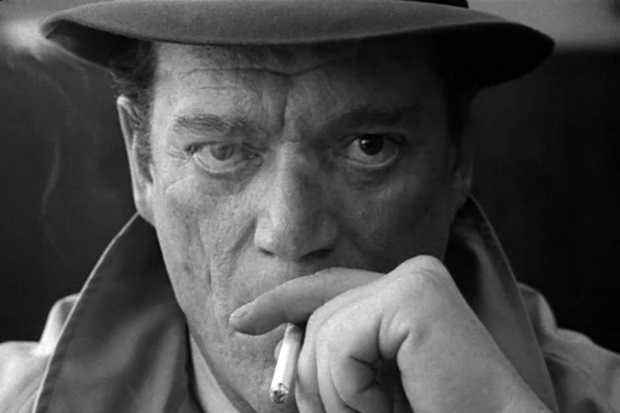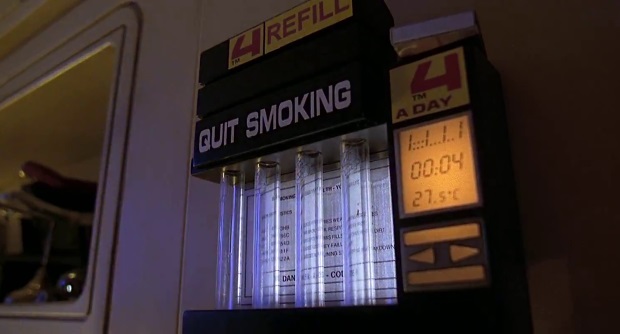Smoking, science fiction, and addiction
Aliya Whiteley returns to Den Of Geek for the second part of her guest series, on addictions in sci-fi...
What makes a film noir? A world-weary detective, a mysterious woman, and organised crime can all play a part. Some might swear that it’s all about a deep sense of disillusionment, or cool jazz, or even wearing hats.
But perhaps in its modern form it’s more of a feeling, a tangible awareness of light and dark and how that’s shown on screen. It occurs to me that another reason crime and science fiction fit together so well is because neither are strict in their definitions; steal a little bit from one and something else from the other, mix them together, and you’ll end up with something that contains familiar elements and yet is able to make new statements, and ask new questions, that resonate for the next generation of genre audiences.
It’s interesting how some of those elements translate so easily to science fiction while other aspects raise an entirely new set of questions.
For instance, back in the film noirs of the 1940s and 50s it would have been inconceivable for our hero not to smoke. Look at the thick smoke hanging in the light from the projector in Billy Wilder’s Sunset Boulevard (1950) or the silhouette of Robert Mitchum, the cigarette smoke rising up and out of the French windows, in Jacques Tourneur’s Out Of the Past (1947) – it was often used as an excuse for intimacy between lovers, the camera closing in on the lips, or to bring movement to a still frame. Great directors used it as a language of its own, and it must be really difficult to decide to not use that language, as a contemporary director, if you’re making a film that deliberately uses noir elements.

Cigarettes also get a lot of screen love in a different genre that paid homage to film noir: the French New Wave. These movies of the late 1950s/1960s often featured all the classic elements of noir, but science fiction was rarely an inspiration – except in the case of Alphaville (1965). Directed by Jean-Luc Godard, it told the tale of Lemmy Caution, a secret agent wearing a hat and a trenchcoat, trying to destroy a city-controlling super-computer.
Does he smoke nonchalantly while carrying out his mission? Of course he does. Lemmy Caution is a character who belongs to the past; he usually appeared in detective novels and films, drinking and smoking heavily while solving cases set in the mid-twentieth century. His transportation wholesale, with all of his addictions in tow, to a dystopian city of the future makes for a fascinating change.
The further we go into the future, the more smoking comes with its own set of complications for the modern audience. We know things about it that a 1940s audience did not, and that has soured our relationship with the screen cigarette. This leaves tough choices for writers and directors who are fans of noir. To smoke, or not to smoke? If a story is set on a recognisable version of Earth then it either has to let the detective protagonist smoke with the dated freedom of Lemmy Caution, or use our current complex relationship with the cigarette. The Fifth Element (1997), Luc Besson’s vivid space adventure, features Bruce Willis as a monosyllabic hard-boiled ex-Special Forces taxi driver who smokes, naturally. But in this cramped, packaged future only four cigarettes are allowed per day; a little machine on the wall dispenses the rations. It’s a great detail in a visually exciting film.

John Constantine is another trench-coat wearing, chain-smoking investigator, starting in comics from The Saga Of Swamp Thing, throughout Hellblazer; then he and his habit made the leap to both film and television. Dangerous Habits, a 1991 six-part story written by Garth Ennis with art by Will Simpson, decided to use his nicotine addiction as an integral part of the plot – his diagnosis with terminal lung cancer. Part of this storyline then appeared in the 2005 movie version, Constantine, with Keanu Reeves playing the detective.
Constantine and his habit live on, still appearing in all sorts of places. Recently, to publicise the short-lived Amazon television series, a three minute Claymation film was made of the character called John Con Noir. It manages to fit in pretty much every noir characteristic you can think of, including a back alley, cool jazz, a deadpan monologue, a femme fatale, and a slow smoking of a cigarette. It’s compressed noir for those who like it quick.
A cigarette can effectively represent the past when creating a very challenging future. Tade Thompson’s novel with noir elements, Rosewater (2016), is set mainly in Nigeria in 2066. Telepath detective Kaaro works for a corrupt government in a city that has sprung up around a mysterious alien dome. This is a complex and involving story about how humanity and technology might interact, and there’s a great moment in the middle of all the action when Kaaro, caught up in a dangerous situation, sits and down and purposefully smokes “an ancient pack of Benson & Hedges”. Thompson takes time to describe the taste of the cigarette, and the curling smoke. It’s a pause before the action, but it’s also a grounding in this story’s noir roots at just the right moment, before pressing on into demanding territory.
You can conjure up the visual effect of the curl of smoke drifting across the scene without having to resort to a cigarette at all. For instance, the movie version of Watchmen (2009) highlights the noir angle of Rorschach’s storyline above all else, but the character wears a full face mask. So smoke rises from other places such as the street vents to fill the screen. It’s a stylish substitute. Incidentally, there’s a purely black and white version of Alan Moore and Dave Gibbons’ original graphic novel that is sold as Watchmen Noir – although to be honest simply removing the colour to make something ‘noir’ feels a bit reductive to me. The character of Rorschach remains the essence of nihilism, walking the bleak city streets in or out of colour.
Part Three of SF Noir Addictions will explore stronger drugs in science fiction detective films, television series and novels.